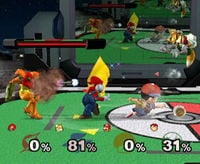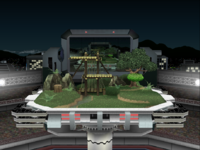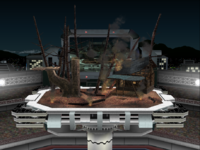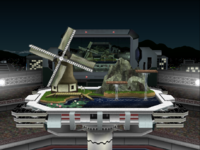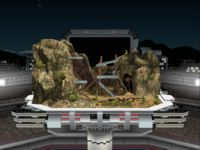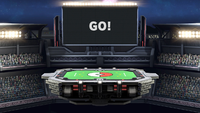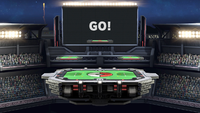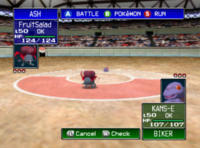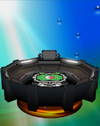Pokémon Stadium
Not to be confused with Pokémon Stadium 2.
| Kanto: Pokémon Stadium | |
|---|---|
{{{content1}}}
{{{content2}}}
{{{content3}}} Pokémon Stadium as it appears in Smash. 
| |
| Universe | Pokémon |
| Appears in | Melee Brawl Ultimate |
| Availability | Starter (Melee and Ultimate) Unlockable (Brawl) |
| Unlock criteria | Play on Pokémon Stadium 2 10 times in the Brawl Mode. |
| Crate type | Futuristic (Brawl) Normal (Ultimate) |
| Maximum players | 4 (Melee and Brawl) 8 (Ultimate) |
| Article on Bulbapedia | Pokémon Stadium (stage) |
| “ | After ten years, it's back! In addition to the basic stadium formation, the stage also switches between Fire, Water, Rock, and Grass variations. If you want to win on this stage, you'll have to alter your strategy based on the current formation! | ” |
| —Super Smash Blog, Super Smash Bros. Ultimate Official Site | ||
Announced at E3 2001, Pokémon Stadium (ポケモンスタジアム, Pokémon Stadium), is a stage debuting in Super Smash Bros. Melee and returning in both Super Smash Bros. Brawl and Super Smash Bros. Ultimate. It is commonly referred to as "Pokémon Stadium 1" to avoid confusion with its similar successor, Pokémon Stadium 2.
In Melee's All-Star Mode, this stage is played on when the player faces Pikachu and any of its teammates.
In Melee, Pichu and Jigglypuff are fought here for their character unlock battles; in Ultimate, Pokémon Trainer is fought here for their character unlock battle.
Stage overview
Basic Version
The basic stage is symmetrical and consists of one large main platform, with two floating soft platforms above. After a varying period of time, the basic stage transforms into a random one of four variants, each based on a type from the Pokémon series. After a while, the stage reverts to the basic form, and the cycle repeats. The same variant can occur consecutively. All forms have an impassable vertical pillar underneath the main platform.
In the background, there is a large jumbotron which can display the battle itself, a symbol representing the upcoming variation during a stage transition, or the current standings of fighters and the match timer. In Brawl, the jumbotron in the background shows the fight in a lower picture definition than in Melee, and uses a new, clearer font for its display.
Grass Version
The Grass variant takes place in some kind of forest or park. The main platform has slightly elevated plateaus on both sides. A small stream separates the left plateau and the central area, causing a slight depression. A wooden structure with two platforms, one above the other, occupies the middle-left part of the stage, while in the right part there is a tree whose branches form a third platform.
Fire Version
The Fire variant takes place in a burning forest. The center of the main platform is occupied by a small depression. On the left side there is a ruined tree: players can stand on top of it, but, due to its height, often need double jumping to reach its top. From the left side of the tree stems a branch which supports a soft floating platform.
On the right side there is a burning shack, the roof of whose porch acts as another soft platform. Note that the fire in the background is purely aesthetic and has no gameplay effect.
Water Version
The Water variant takes place near a pond or lake. The whole right side is occupied by a flat pond, while on the left there is a small elevated pier which slopes down on both its sides. Over the pond, two soft platforms are suspended by water spouts, the right one higher than the left one.
On the left side there is a windmill. Its arms spin slowly and can be stood upon, but players on the current lowest arm fall. The arms are soft in Melee but hard in Brawl.
Rock Version
The Rock variant takes place in a canyon near a mine. Its terrain is the most uneven of all versions. The right part is flat and empty, while in the middle there are three soft platforms one above the other, of which the bottom one touches the ground and can be walked up from it.
The left side is occupied by a large solid mountain, on whose right side stem two more soft platforms. The walls it creates can cause infinites and caves of life. The top of the mountain itself acts as a solid platform. The mountain's left side is almost vertical and ends almost at the right edge of the stage, leaving a small walkable space.
Ω form and Battlefield form
In Super Smash Bros. Ultimate, the Ω form and Battlefield form are set on the default transformation of the regular form and does not transform into any of the four variants. The main platform is also resized and reshaped to match Final Destination and Battlefield, respectively. The three soft platforms of the Battlefield form are based on the ones in the normal form.
Hazards Off
With hazards off in Ultimate, the stage remains in the Basic Version for the whole match.
Origin
While the stage is not specifically based on anything from the Pokémon video game series, it may be a general representation of a Gym. A possible specific origin could be the Pokémon Stadium games, from which the stage's name possibly comes from and whose arenas in-game feature a Poké Ball logo in the middle, a crowd watching the battle and, in the case of Gym Leader battles, type-related aesthetics. However, the arenas in the Pokémon Stadium games, including the type-themed ones, do not affect the battles in any way.
Another possible source is the Pokémon anime, in which, during tournament battles, the arena changes its terrain frequently to hinder or help either Pokémon. This was seen at least in the preliminary rounds of the Indigo League, during which each of Ash Ketchum's four initial battles was in a different battlefield representing a specific elemental type.
Tournament legality
Melee
Pokémon Stadium was one of the few stages that people in tournaments have almost never questioned being legal, and for a long time, was a starter. Many people considered Pokémon Stadium to be one of the fairest stages in Melee because the shifting terrain was generally not very disruptive to gameplay, and for some time, was thought to prevent excessive projectile camping. However, recent metagame developments have shown that Fox and Falco have a very large advantage on this stage because the geometry of the stage and terrain allowed them to projectile camp with Blaster very safely. It is also the only legal stage with walls, allowing Fox to perform the drill shine infinite. The large horizontal size of the stage benefits their movement greatly, while hindering other characters who cannot traverse across the stage as easily, while the low ceiling allows even earlier KOs for Fox's two main finishers. The transformations also benefit Falco, and especially Fox, greatly in several matchups by either giving them more room to approach or safe spots to camp in.
While the long stage size, platform placement of the main stage, and low ceiling can also benefit characters with good dash dances such as Marth and Captain Falcon, the advantages that these characters gain pale in comparison to the aforementioned advantages realized by Fox and Falco. As such, it has been deemed a counterpick stage in more recent rulesets, with some Melee players arguing that it should even be banned because the advantages given to those two characters are far too overwhelming for the majority of the cast.
Some tournaments, such as Battle of BC 3 have replaced Pokemon Stadium with Frozen Pokemon Stadium, a mod which disables stage transformations for Pokemon Stadium, making the stage stay on the Basic Version for the entirety of the match. The use of this in tournament has caused controversy, with many opposing the use of mods that cause significant changes to melee's gameplay.
Brawl
The stage is more debatable in its neutrality; while it is a starter in the Unity Ruleset and always in seven-stage starter lists, Lylat Cruise is often chosen over it in five-stage starter lists, while never being a starter in three-stage starter lists. The change in unquestioned neutrality comes from changes to the stage itself: first, the lips at the edges of the stage are much more thin and deceptive, occasionally flustering recoveries from slightly underneath the stage or even regular recoveries away from the stage. The most notable change in the stage, however, comes from the redesigned water transformation: while it looks almost the same as in Melee, the blades of the windmill are no longer soft platforms and cannot be passed through in any direction, resulting in stage traversal difficulties and significant caves of life. Additionally, due to the metagame's more defensive nature, Brawl players tend to camp out the Rock and Fire transformations, hiding behind the large rock and the tree until the transformation has ended, slowing down gameplay and matches.
Ultimate
The stage is usually banned, as it has too many similarities to Pokémon Stadium 2 when hazards are turned off. Some regions however have Pokémon Stadium as a legal starter over Pokémon Stadium 2, most notably Chicago and MD/VA. This is mainly due to some players believing the stage is a more reasonable size when compared to Pokémon Stadium 2
Trophy
- Pokémon Stadium
Trainers come from far and wide to congregate at Pokémon Stadiums, the ultimate venues to show off their Pokémon teams. There are many different arenas with varying terrain designs, some of which afford advantages to certain Pokémon. This particular stadium is reserved for huge events and boasts a big screen and spectacular fireworks.
Glitches
Super Smash Bros. Melee
- On the fire variant, if a character gets hit towards the right side of the tree's base, there's a chance they will fall through.
Super Smash Bros. Brawl
- On the forest variant stage, if a character walks onto the very left where the tree stump is while it is forming, they will fall through.
Gallery
Super Smash Bros. Melee
Super Smash Bros. Brawl
Super Smash Bros. Ultimate
King Dedede with a Poké Ball after performing his forward smash on the stage.
- BrawlerPacManPokémonStadiumUltimateBattleStartJumbotronGO!.jpg
Mii Brawler and Pac-Man on the stage with the jumbotron showing "GO!" to signal the start of the match.
- SpringManPokémonStadium.jpg
Spring Man on the stage.
Trivia
General
- The icons flashing on the jumbotron, which denote the arena types, are derived from the type symbols of the Trading Card Game, and in an early version of Melee, they looked exactly the same.
- The icon that flashes when the stage is about to change into its Water form is the tidal wave from Japanese painter Hokusai's famous painting, The Great Wave off Kanagawa.
- Since the jumbotron takes up a large part of the stage, whenever it displays the match, the images on the jumbotron are replicated inside the projected jumbotron and so on, creating a Droste effect.
- When a player opens up the menu in Training Mode, the jumbotron will follow the game camera's zoom in on their character.
- This is the only Pokémon stage to not feature any Pokémon in any capacity.
- This stage shares its name with the game Pokémon Stadium. Despite that, the stage features no references to it or its sequel.
Super Smash Bros. Melee
- Venusaur, along with other Pokémon, were originally planned to appear on the stage. However, this idea was scrapped, and Venusaur was instead a Poké Ball Pokémon in Melee. Background Pokémon would later be present on Pokémon Stadium 2.
- When the jumbotron displays the "Current Leader", the font of the character's names matches that color of their player port.
- Additionally, in Team Battles, the color of the CPU players' names matches their respective teams color but with less saturation.
- When playing on this stage in Training Mode, the stage will not transform and the jumbotron only focuses on the battle or zooms in on one of the characters.
Super Smash Bros. Brawl
- If Zero Suit Samus is currently on the stage, the jumbotron will display her name as "Samus" instead of "Zero Suit Samus". This also happens in Pokémon Stadium 2 and PictoChat.
- When the jumbotron displays the current leader, it will show only one character's name even if there's currently a tie between multiple characters for the highest score/stock count.
- Additionally in Team Battles, the jumbotron only displays the character leading the team with the higher score rather than the entire winning team.
- In the Water form, it's possible for small items to get stuck in the windmill. This can be done by dropping and/or throwing an item so it lands in the center of the windmill just as it becomes solid. Poké Balls will not activate while stuck there.
- This is the only past stage in Brawl to have three music tracks.
- Whenever either this stage or Pokémon Stadium 2 is featured in an event match, the jumbotron will not display "SUCCESS" when clearing the event, but will display "FAILURE" if the event end in a failure. This was fixed for both stages in the PAL version.
Super Smash Bros. Ultimate
- When playing a game of Squad Strike, the names of the characters on the jumbotron will not change until it updates itself. This also happens on Pokémon Stadium 2.
- This also happens when adding more CPU opponents in Training Mode.
- Much like in Melee, the names of all the characters on either the "Current Stage" or "Current Leader" on the jumbotron will match the color of their player slot.
- When playing in a Team Battle, the jumbotron displays all character names in the order of red, blue, green, and yellow.
- In Team Battles, the jumbotron only displays the names of all characters with the highest score/stock count rather than the winning team.
- In Training Mode, the jumbotron never displays the current stage or the current leader.
- Pokémon Trainer and Greninja are the only characters to travel to this stage more than once in their own Classic Mode route.
- In either a Stock or Stamina match, if a player slot is skipped, the jumbotron sometimes displays the wrong player number if a player loses their last life. For example, in a 3-player Smash involving P2, P3 and P4, if Player 2 gets defeated, the jumbotron displays "Player 1 Defeated" despite player 1 not being present.
See also
| Stages in Super Smash Bros. Melee | |
|---|---|
| Starter stages | Brinstar · Corneria · Fountain of Dreams · Great Bay · Green Greens · Icicle Mountain · Jungle Japes · Kongo Jungle · Mushroom Kingdom · Mute City · Onett · Pokémon Stadium · Princess Peach's Castle · Rainbow Cruise · Temple · Venom · Yoshi's Island · Yoshi's Story |
| Unlockable stages | Battlefield · Big Blue · Brinstar Depths · Final Destination · Flat Zone · Fourside · Mushroom Kingdom II · Poké Floats |
| Dream Land · Kongo Jungle · Yoshi's Island | |
